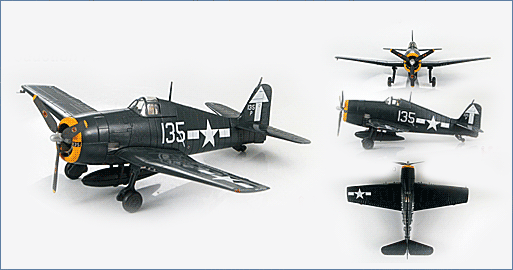Air Power Series>1:72 die-cast display model>F6F>HA1114
Grumman F6F-5P "Hellcat" VF-84, USS Bunker Hill, Feb 1945 "135"

General Background
The F6F Hellcat was basically designed as the “Zero Killer”. It could fly about an average 55 mph faster than the Zero and it was heavier and more powerful than the Zero. The Hellcat also had the highest kill ratio of any American fighter plane during WWII (19 to1). US Navy pilots referred the Hellcat as the "Aluminum Tank".
The Hellcat could carry two 1,000 pound bombs with its most destructive weapons being six 5-inch HVAR's (High Velocity Aircraft Rockets). It could also carry a torpedo under the fuselage but this was never seen in combat. When it was all over the F6F was one of the most feared and successful planes in WWII.
The Hellcat could carry two 1,000 pound bombs with its most destructive weapons being six 5-inch HVAR's (High Velocity Aircraft Rockets). It could also carry a torpedo under the fuselage but this was never seen in combat. When it was all over the F6F was one of the most feared and successful planes in WWII.
The Aircraft
VF-84 took part in the invasion of Iwo Jima; raids on Tokyo and other
targets in Japan; the discovery and sinking of the Japanese battleship
Yamato, the largest warship in the world; and support of the invasion
of Okinawa.
On 11 May 1945, while off Okinawa, two Japanese kamikazes struck the carrier in quick succession. A bomb carried by one penetrated to the pilots' ready room. 22 members of VF-84 lost their lives in the attack. Both the carrier (then the flagship) and its air group were knocked out of the war. Although VF-84 was reformed in July as an F6F Hellcat squadron, the war ended while it was still at its base in the United States. The squadron was disestablished on 8 October 1945.
On 11 May 1945, while off Okinawa, two Japanese kamikazes struck the carrier in quick succession. A bomb carried by one penetrated to the pilots' ready room. 22 members of VF-84 lost their lives in the attack. Both the carrier (then the flagship) and its air group were knocked out of the war. Although VF-84 was reformed in July as an F6F Hellcat squadron, the war ended while it was still at its base in the United States. The squadron was disestablished on 8 October 1945.
Specifications :
| Total production : | F6F-3 (4,403), F6F-5 (7,870) |
| Powerplant : | Single 2,000-horsepower 18-cylinder, Pratt and Whitney R-2800-10W air cooled radial engine |
| Climb rate to 14,000 ft. : | 6 minutes 42 seconds |
| Wingspan : | 42 ft. 10 in. (13.1 m) |
| Length : | 33 ft., 7 in. (10.2 m) |
| Height : | 13 ft., 1 in. (4.0 m) |
| Weight : | 9,238 lb. empty |
| Maximum speed : | 380 mph at 23,400 ft. |
| Ceiling : | 37,300 ft. |
| Range : | 945 miles |
| Armament : | six .50-caliber M2 Browning machine guns |
| a 2,000 lb. bomb load, or six 5-inch rockets |

